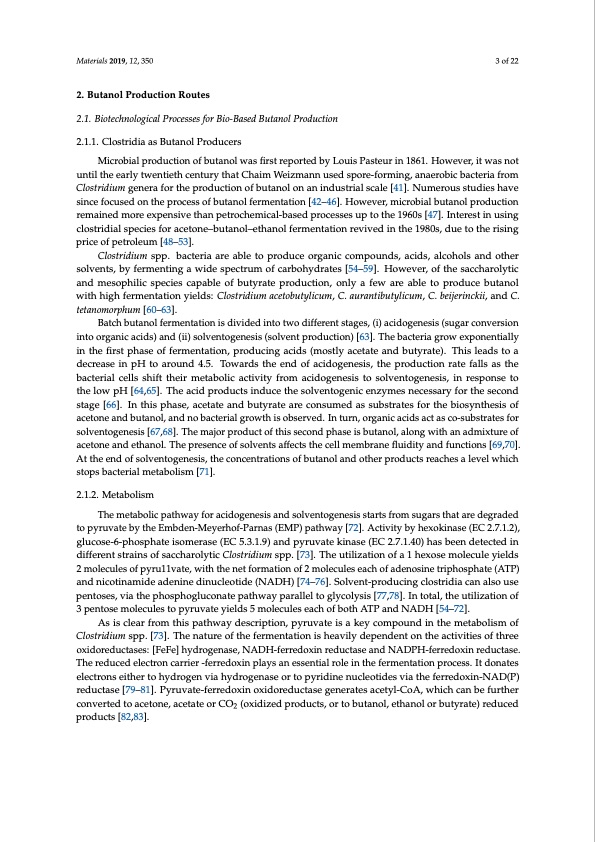
PDF Publication Title:
Text from PDF Page: 003
Materials 2019, 12, 350 3 of 22 2. Butanol Production Routes 2.1. Biotechnological Processes for Bio-Based Butanol Production 2.1.1. Clostridia as Butanol Producers Microbial production of butanol was first reported by Louis Pasteur in 1861. However, it was not until the early twentieth century that Chaim Weizmann used spore-forming, anaerobic bacteria from Clostridium genera for the production of butanol on an industrial scale [41]. Numerous studies have since focused on the process of butanol fermentation [42–46]. However, microbial butanol production remained more expensive than petrochemical-based processes up to the 1960s [47]. Interest in using clostridial species for acetone–butanol–ethanol fermentation revived in the 1980s, due to the rising price of petroleum [48–53]. Clostridium spp. bacteria are able to produce organic compounds, acids, alcohols and other solvents, by fermenting a wide spectrum of carbohydrates [54–59]. However, of the saccharolytic and mesophilic species capable of butyrate production, only a few are able to produce butanol with high fermentation yields: Clostridium acetobutylicum, C. aurantibutylicum, C. beijerinckii, and C. tetanomorphum [60–63]. Batch butanol fermentation is divided into two different stages, (i) acidogenesis (sugar conversion into organic acids) and (ii) solventogenesis (solvent production) [63]. The bacteria grow exponentially in the first phase of fermentation, producing acids (mostly acetate and butyrate). This leads to a decrease in pH to around 4.5. Towards the end of acidogenesis, the production rate falls as the bacterial cells shift their metabolic activity from acidogenesis to solventogenesis, in response to the low pH [64,65]. The acid products induce the solventogenic enzymes necessary for the second stage [66]. In this phase, acetate and butyrate are consumed as substrates for the biosynthesis of acetone and butanol, and no bacterial growth is observed. In turn, organic acids act as co-substrates for solventogenesis [67,68]. The major product of this second phase is butanol, along with an admixture of acetone and ethanol. The presence of solvents affects the cell membrane fluidity and functions [69,70]. At the end of solventogenesis, the concentrations of butanol and other products reaches a level which stops bacterial metabolism [71]. 2.1.2. Metabolism The metabolic pathway for acidogenesis and solventogenesis starts from sugars that are degraded to pyruvate by the Embden-Meyerhof-Parnas (EMP) pathway [72]. Activity by hexokinase (EC 2.7.1.2), glucose-6-phosphate isomerase (EC 5.3.1.9) and pyruvate kinase (EC 2.7.1.40) has been detected in different strains of saccharolytic Clostridium spp. [73]. The utilization of a 1 hexose molecule yields 2 molecules of pyru11vate, with the net formation of 2 molecules each of adenosine triphosphate (ATP) and nicotinamide adenine dinucleotide (NADH) [74–76]. Solvent-producing clostridia can also use pentoses, via the phosphogluconate pathway parallel to glycolysis [77,78]. In total, the utilization of 3 pentose molecules to pyruvate yields 5 molecules each of both ATP and NADH [54–72]. As is clear from this pathway description, pyruvate is a key compound in the metabolism of Clostridium spp. [73]. The nature of the fermentation is heavily dependent on the activities of three oxidoreductases: [FeFe] hydrogenase, NADH-ferredoxin reductase and NADPH-ferredoxin reductase. The reduced electron carrier -ferredoxin plays an essential role in the fermentation process. It donates electrons either to hydrogen via hydrogenase or to pyridine nucleotides via the ferredoxin-NAD(P) reductase [79–81]. Pyruvate-ferredoxin oxidoreductase generates acetyl-CoA, which can be further converted to acetone, acetate or CO2 (oxidized products, or to butanol, ethanol or butyrate) reduced products [82,83].PDF Image | Butanol Synthesis Routes for Biofuel Production

PDF Search Title:
Butanol Synthesis Routes for Biofuel ProductionOriginal File Name Searched:
materials-12-00350.pdfDIY PDF Search: Google It | Yahoo | Bing
NFT (Non Fungible Token): Buy our tech, design, development or system NFT and become part of our tech NFT network... More Info
IT XR Project Redstone NFT Available for Sale: NFT for high tech turbine design with one part 3D printed counter-rotating energy turbine. Be part of the future with this NFT. Can be bought and sold but only one design NFT exists. Royalties go to the developer (Infinity) to keep enhancing design and applications... More Info
Infinity Turbine IT XR Project Redstone Design: NFT for sale... NFT for high tech turbine design with one part 3D printed counter-rotating energy turbine. Includes all rights to this turbine design, including license for Fluid Handling Block I and II for the turbine assembly and housing. The NFT includes the blueprints (cad/cam), revenue streams, and all future development of the IT XR Project Redstone... More Info
Infinity Turbine ROT Radial Outflow Turbine 24 Design and Worldwide Rights: NFT for sale... NFT for the ROT 24 energy turbine. Be part of the future with this NFT. This design can be bought and sold but only one design NFT exists. You may manufacture the unit, or get the revenues from its sale from Infinity Turbine. Royalties go to the developer (Infinity) to keep enhancing design and applications... More Info
Infinity Supercritical CO2 10 Liter Extractor Design and Worldwide Rights: The Infinity Supercritical 10L CO2 extractor is for botanical oil extraction, which is rich in terpenes and can produce shelf ready full spectrum oil. With over 5 years of development, this industry leader mature extractor machine has been sold since 2015 and is part of many profitable businesses. The process can also be used for electrowinning, e-waste recycling, and lithium battery recycling, gold mining electronic wastes, precious metals. CO2 can also be used in a reverse fuel cell with nafion to make a gas-to-liquids fuel, such as methanol, ethanol and butanol or ethylene. Supercritical CO2 has also been used for treating nafion to make it more effective catalyst. This NFT is for the purchase of worldwide rights which includes the design. More Info
NFT (Non Fungible Token): Buy our tech, design, development or system NFT and become part of our tech NFT network... More Info
Infinity Turbine Products: Special for this month, any plans are $10,000 for complete Cad/Cam blueprints. License is for one build. Try before you buy a production license. May pay by Bitcoin or other Crypto. Products Page... More Info
| CONTACT TEL: 608-238-6001 Email: greg@infinityturbine.com | RSS | AMP |